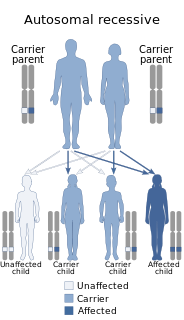
Holoprosencephaly (HPE) is a cephalic disorder in which the prosencephalon fails to develop into two hemispheres. Normally, the forebrain is formed and the face begins to develop in the fifth and sixth weeks of human pregnancy. The condition also occurs in other species.

Collagen, type II, alpha 1 , also known as COL2A1, is a human gene that provides instructions for the production of the pro-alpha1(II) chain of type II collagen.

Cohen syndrome is a very rare autosomal recessive genetic disorder with varied expression, characterised by obesity, intellectual disability, distinct craniofacial abnormalities and potential ocular dysfunction.

Robinow syndrome is an extremely rare genetic disorder characterized by short-limbed dwarfism, abnormalities in the head, face, and external genitalia, as well as vertebral segmentation. The disorder was first described in 1969 by human geneticist Meinhard Robinow, along with physicians Frederic N. Silverman and Hugo D. Smith, in the American Journal of Diseases of Children. By 2002, over 100 cases had been documented and introduced into medical literature.

7-Dehydrocholesterol reductase, also known as DHCR7, is a protein that in humans is encoded by the DHCR7 gene.

Rivka Carmi is an Israeli pediatrician and geneticist. She served as President of Ben-Gurion University of the Negev (BGU) in May 2006-December 2018. Carmi is the first woman to be appointed president of an Israeli university.
Fitzsimmons–Guilbert syndrome is an extremely rare genetic disease characterized by a slowly progressive spastic paraplegia, skeletal anomalies of the hands and feet with brachydactyly type E, cone-shaped epiphyses, abnormal metaphyseal–phalangeal pattern profile, sternal anomaly, dysarthria, and mild intellectual deficit.

Aristaless related homeobox is a protein that in humans is encoded by the ARX gene.

Cartilage oligomeric matrix protein (COMP), also known as thrombospondin-5, is an extracellular matrix (ECM) protein primarily present in cartilage. In humans it is encoded by the COMP gene.

Paraplegin is a protein that in humans is encoded by the SPG7 gene located on chromosome 16.

Spartin is a protein that in humans is encoded by the SPG20 gene.

Boomerang dysplasia is a lethal form of osteochondrodysplasia known for a characteristic congenital feature in which bones of the arms and legs are malformed into the shape of a boomerang. Death usually occurs in early infancy due to complications arising from overwhelming systemic bone malformations.

Arylsulfatase E, also known as ARSE, is an enzyme that, in humans, is encoded by the ARSE gene.

Desmosterolosis is a defect in cholesterol biosynthesis. It results in an accumulation of desmosterol and a variety of associated symptoms. Only two cases have been reported as of 2007. The condition is due to inactivating mutations in 24-dehydrocholesterol reductase. Certain anticholesterolemic and antiestrogenic drugs such as triparanol, ethamoxytriphetol, and clomifene have been found to inhibit conversion of desmosterol into cholesterol and to induce desmosterolosis, for instance cataracts.

Lujan–Fryns syndrome (LFS) is an X-linked genetic disorder that causes mild to moderate intellectual disability and features described as Marfanoid habitus, referring to a group of physical characteristics similar to those found in Marfan syndrome. These features include a tall, thin stature and long, slender limbs. LFS is also associated with psychopathology and behavioral abnormalities, and it exhibits a number of malformations affecting the brain and heart. The disorder is inherited in an X-linked dominant manner, and is attributed to a missense mutation in the MED12 gene. There is currently no treatment or therapy for the underlying MED12 malfunction, and the exact cause of the disorder remains unclear.

Smith–Fineman–Myers syndrome (SFMS1) is a congenital disorder that causes birth defects. This syndrome was named after Richard D. Smith, Robert M. Fineman and Gart G. Myers who discovered it around 1980.
Opsismodysplasia is a type of skeletal dysplasia first described by Zonana and associates in 1977, and designated under its current name by Maroteaux (1984). Derived from the Greek opsismos ("late"), the name "opsismodysplasia" describes a delay in bone maturation. In addition to this delay, the disorder is characterized by micromelia, particularly of the hands and feet, delay of ossification, platyspondyly, irregular metaphyses, an array of facial aberrations and respiratory distress related to chronic infection. Opsismodysplasia is congenital, being apparent at birth. It has a variable mortality, with some affected individuals living to adulthood. The disorder is rare, with an incidence of less than 1 per 1,000,000 worldwide. It is inherited in an autosomal recessive pattern, which means the defective (mutated) gene that causes the disorder is located on an autosome, and the disorder occurs when two copies of this defective gene are inherited. No specific gene has been found to be associated with the disorder. It is similar to spondylometaphyseal dysplasia, Sedaghatian type.

Acetyl-coenzyme A transporter 1 also known as solute carrier family 33 member 1 (SLC33A1) is a protein that in humans is encoded by the SLC33A1 gene.
Spastic paraplegia 23 is a 25cM gene locus at 1q24-q32. A genomewide linkage screen has associated this locus with a type of hereditary spastic paraplegia (HSP).

L1 syndrome is a group of mild to severe X-linked recessive disorders that share a common genetic basis. The spectrum of L1 syndrome disorders includes X-linked complicated corpus callosum agenesis, spastic paraplegia type 1, MASA syndrome, and X-linked hydrocephalus with stenosis of the aqueduct of Sylvius (HSAS). It is also called L1CAM syndrome and CRASH syndrome, an acronym for its primary clinical features: corpus callosum hypoplasia, retardation, adducted thumbs, spasticity, and hydrocephalus.














